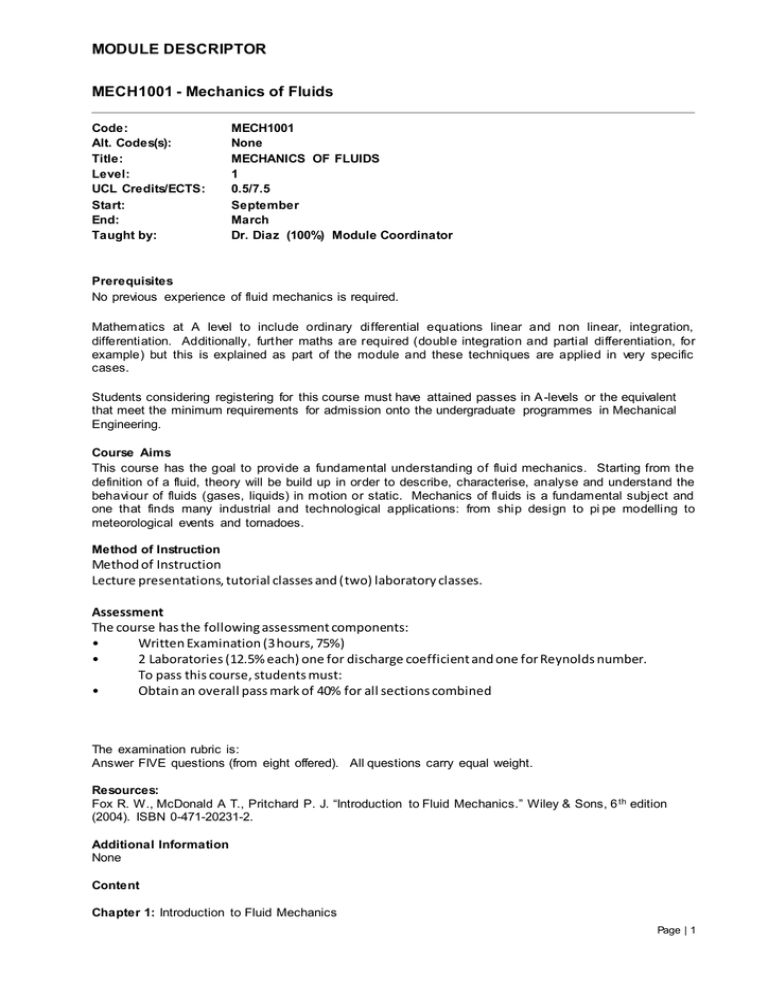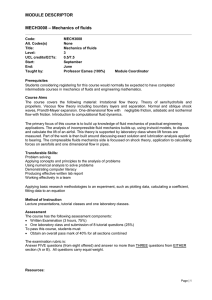MODULE DESCRIPTOR MECH1001 - Mechanics of Fluids
advertisement

MODULE DESCRIPTOR MECH1001 - Mechanics of Fluids Code: Alt. Codes(s): Title: Level: UCL Credits/ECTS: Start: End: Taught by: MECH1001 None MECHANICS OF FLUIDS 1 0.5/7.5 September March Dr. Diaz (100%) Module Coordinator Prerequisites No previous experience of fluid mechanics is required. Mathematics at A level to include ordinary differential equations linear and non linear, integration, differentiation. Additionally, furt her maths are required (double integration and partial differentiation, for example) but this is explained as part of the module and these techniques are applied in very specific cases. Students considering registering for this course must have attained passes in A -levels or the equivalent that meet the minimum requirements for admission onto the undergraduate programmes in Mechanical Engineering. Course Aims This course has the goal to provide a fundamental understanding of fluid mechanics. Starting from the definition of a fluid, theory will be build up in order to describe, characterise, analyse and understand the behaviour of fluids (gases, liquids) in motion or static. Mechanics of fluids is a fundamental subject and one that finds many industrial and technological applications: from ship design to pi pe modelling to meteorological events and tornadoes. Method of Instruction Method of Instruction Lecture presentations, tutorial classes and (two) laboratory classes. Assessment The course has the following assessment components: • Written Examination (3 hours, 75%) • 2 Laboratories (12.5% each) one for discharge coefficient and one for Reynolds number. To pass this course, students must: • Obtain an overall pass mark of 40% for all sections combined The examination rubric is: Answer FIVE questions (from eight offered). All questions carry equal weight. Resources: Fox R. W., McDonald A T., Pritchard P. J. “Introduction to Fluid Mechanics.” Wiley & Sons, 6 th edition (2004). ISBN 0-471-20231-2. Additional Information None Content Chapter 1: Introduction to Fluid Mechanics Page | 1 Definitions (fluids, continuum, etc.). Dimensions and unit systems. Chapter 2: Fluid Properties Mass, weight and density. Temperature. Viscosity. Pressure Chapter 3: Fluid Statics Distribution of pressure in a fluid at rest. Fundament al equilibrium condition applied to (i) liquids, (ii) gases. Manometry. Forces on immersed surfaces in liquids. Archimedes’ principle. Pressure distribution in accelerated fluids; translation, rotation. Chapter 4: Conservation Equations in Integral Form Classification of flows. Definitions (streamlines, pathlines, etc.) Conservation of mass Conservation of momentum applied to a control volume Examples: applications to blades, vanes, cascades, contractions, nozzles, jets, flat plate boundary layer. Chapter 5: Incompressible Inviscid Flow Bernoulli’s equation. Static, dynamic and stagnation pressure. Pitot tube, stagnation point, static pressure hole. Pitot-static tube, free stream dynamic pressure. Dimensionless pressure coefficient. Flow measurement or metering. Orifices, venturis, ducts, nozzles. Empirical discharge coefficients. Steady flow energy equation. Relation to Bernoulli. Head loss due to friction. Power input to a pump. Chapter 6: Dimensional Analysis and Similitude Similarity and modelling. Model testing. Chapter 7: Internal Incompressible Viscous Flow Effect of viscosity. Shear stress and velocity gradient. Wall shear stress. Reynolds’ experiments in pipes, laminar motion, transition, turbulent motion. Dynamic similarity. Reynolds number. Analysis of pipe flow: Hagen-Poiseuille theory for laminar flows. Friction factor. Darcy’s equation for head loss. Empirical results for turbulent flow. Velocity profiles. 1/7 th power law. Friction factor correlations. Head loss coefficients for valves bends, etc. Applications in pipe networks and in draining/filling problems. Quasi-steady flow. Chapter 8: External Incompressible Viscous Flow Dimensionless force coefficients. Drag coefficient. Lift coefficient. Bluff and slender bodies. Nature of real flows at high Reynolds number. Boundary layers. Phenomenon of separation. Favourable and adverse pressure gradients. Contribution to total profile drag. Form drag, skin friction. General Learning Outcomes Knowledge and understanding: Essential scientific principles of fundamental fluid mechanics, which includes: a basic knowledge and understanding of fluid statics and Bernoulli's equation, the conservation principles for open systems and basic knowledge and understanding of the principles of dimensional analysis and physical similarity. Skills and attributes (i) Intellectual Apply basic scientific principles of fluid mechanics to solve simple engineering problems involving modelling and analysis of basic engineering systems involving: simple flow systems, using appropriate conservation principles, and applying the principles of dimensional analysis and physical similarity to engineering model testing. (ii) Practical Use pressure, temperature and flow measurement in dedicated test equipment and wind tunnels; analyse experimental results and draw conclusions, given specific guidance to the appropriate background material; estimate uncertainty of simple fluid mechanics and thermodynamics measurements. Page | 2 (iii) Transferable: Apply a range of techniques to analyse available evidence and solve simple engineering problems pertaining in fluid flow systems. Page | 3




